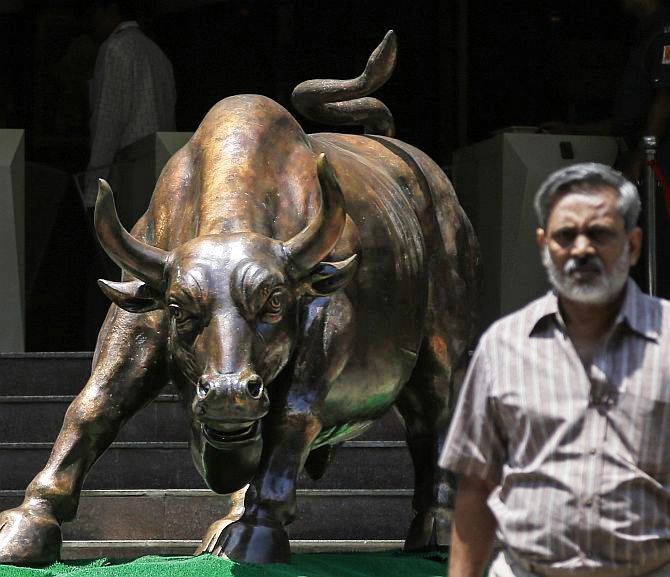
Sensex’s price to book value of 2.9 makes it the most expensive index in developed or emerging markets
India’s stock market indices are among the most expensive in the world.
The BSE Sensex and NSE Nifty, benchmarks on the two major bourses, are trading at nearly 2.9 times their book value, higher than most other indices in both developed and emerging markets.
The S&P 500 in America trades at 2.8x, Indonesia’s benchmark index at 2.3x and the Shanghai benchmark at 1.6x the trailing 12-month underlying book value.
The Indian indices also offer one of the lowest dividend yields.
In the same vein, some of India’s high-flying stocks such as Hindustan Unilever, Shree Cement, Asian Paints, Eicher Motors, Gruh Finance and Ashok Leyland are among the most expensive in their sectors across the globe.
Eicher trades at nearly 15x its book value, compared with Harley-Davidson’s 4.5x. Shree Cement is trading at 7.5 times its book value (or common equity per share), making it the most expensive cement stock in the world.
Most of its peer firms in developed and emerging nations are trading at one to two times their book value.
At its current stock price, Asian Paints is the world’s second most expensive paint stock, behind America’s Sherwin-Williams Company.
Asian Paints is valued at 17.5x its book value, behind Sherwin-Williams’ 27x and ahead of other global paint majors such as PPG Industries, Kansai Paint Co and Nippon Paint.
Similarly, Hindustan Unilever is by far the most expensive among fast moving consumer goods companies, and among personal care product ones, in the world -- it trades at nearly 47 times its book value.
Global peers such as P&G, Unilever, L’Oreal and Pigeon Corp are trading at four to eight times their book value.
In financial services, HDFC Bank and Gruh Finance are among the most expensive stocks in the world, trading at a huge premium to their book unlike their global peers.
The analysis is based on the latest price to book value ratio of the world’s major benchmark equity indices, sourced from the Bloomberg data base.
The analysis uses P/B because the price to earnings multiple has been distorted for many indices because of a sharp decline in the profitability of commodity and energy producers.
The book value is not impacted much by short-term changes in profitability.
For example, the Brazilian benchmark IBovespa’s P/E multiple at 83 is nearly four times that of the BSE Sensex but its P/B ratio is less than half that of the latter.
Similarly, Britain’s FTSE 100 is nearly twice as expensive as the Sensex on P/E multiple but nearly 40 per cent cheaper on P/B.
Both these indices are dominated by metal and mining companies, whose profitability has been hit hard by the plunge in commodity prices.
Analysts attribute this to higher return ratios in India, beside faster earnings growth.
At 15 per cent, the Sensex offers one of the highest returns on equity among the world’s major indices.
In comparison, the S&P 500’s RoE is around 12 per cent; the Shanghai benchmark offers 11.6 per cent.
“Except for a few blips, India has historically been a growth story in the past two decades.
"Even in times when growth has faltered, expectations of earnings upgrades and bullish forecasts has ensured we’ve remained a premium market for the most part,” said G Chokkalingam, founder, Equinomics Research and Advisory.
Many stocks in India also get a scarcity premium, due to a combination of low free-float and relatively better financial performance.
“Only a few sectors have been doing well for the past two years.
"As a result, investors have been chasing fewer stocks, placing a super-premium on a select few,” said Chokkalingam.
Gruh Finance, Shree Cement, Hindustan Unilever and Asian Paints have a low float.
Meaning, the bulk of the shares are held by promoters and a lesser number of shares are available for trading.
The limited supply and the higher demand has accentuated the premium commanded by these stocks, making them the most expensive worldwide.
Ajay Bodke, head of portfolio management services at Prabhudas Lilladher, attribute India’s premium valuation to the country’s low reliance on commodity exporters.
“Unlike other emerging markets, India’s benchmark indices are dominated by large information technology, FMCG and pharmaceutical firms -- businesses characterised by high return ratios, efficient use of capital and strong free-cash flows.
"These firms get a premium valuation, resulting in Indian indices trading at a premium to other commodity exporting markets.”
Rich valuations, however, become risky when macro economic winds turn direction.
For instance, if crude oil prices were to continue an upward march, many paint companies and energy-intensive sectors such as cement could face margin profit turbulence, owing to the rise in their input cost.
This calls for a higher margin of safety for investors.
Image: A man walks past the Bull at the Bombay Stock Exchange. Photograph: Reuters

.jpg)










 © 2025
© 2025